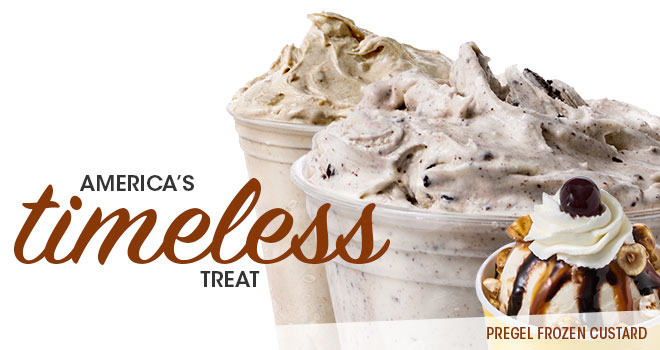It sounds cliché, but frozen custard lovers across the United States might agree that the simplicity of this long-loved treat is what makes it phenomenal. At nearly 100 years old, frozen custard is still causing as much of a stir as it did when it was introduced to the American public in 1919 as a carnival treat in Coney Island, New York. Though it is currently known as a frozen delicacy specific to Milwaukee, Wisconsin – the “Custard Capital of the World” – frozen custard continues to make a strong impression across the United States … despite there still being a bit of confusion about what the frosty delight actually is.
Often confused with pudding, pastry filling, or something associated with pies, frozen custard is in fact a gourmet ice cream that is dense, slow to melt and extremely creamy. It is also a very precise dessert, meaning it has to meet certain criteria to be classified as frozen custard. For instance, when made in a proper continuous batch freezer, there should be an overrun (incorporation of air) of 15-30% depending on the machine – similar to gelato. Additionally, the FDA requires products marketed as frozen custard to contain at least 10% milkfat and 1.4% egg yolk solids.
America’s beloved eggy treat can also be offered in scoops, milkshakes, and affogatos.
Eggs play an important role in frozen custard, as this one ingredient is what gives the concoction its “custardy” appeal. As reported on www.kohrstheoriginal.com, creators of frozen custard, Archie and Elton Kohr, allegedly began using egg in their frozen dessert mix after noticing that the addition of the natural stabilizer helped prevent the salty sea air from rapidly melting the finished dessert when they were initially selling it on the seashore of Coney Island. But aside from the stabilizing aspect, egg yolks also give frozen custard an attractive light yellow hue, and enhances the flavor of vanilla – one of the two standard flavors of frozen custard; the other being chocolate.

There are indeed similarities between frozen custard and traditional ice cream, though they are slight. Ice cream recipes generally include milk, cream, or a combination of the both, whereas frozen custard demands milk, cream, and egg yolks. Indeed, ice cream can use eggs – technically making it custard – but eggs are not a requirement as in the case of frozen custard. Additionally, frozen custard incorporates much less air into the mix than ice cream; therefore producing a more dense taste experience, where ice cream usually has more air churned into its mix for lighter, fluffier results, and is then placed in a freezer to firm up before it can be scooped. Furthermore, custard is typically served directly from the machine at warmer temperatures than ice cream, providing for a warmer mouthfeel, more intense flavor, and less ice crystals, producing a “silky” smooth texture that American palates have come to love.
Keeping in mind that frozen custard is a very versatile product. Sure, it can be enjoyed soft serve style, but concretes – a super-thick shake made of frozen custard and chunky mix-ins – has taken off in frozen custard shops across the country. America’s beloved eggy treat can also be offered in scoops, milkshakes, and affogatos. Whether made from a liquid base or powdered mix, no matter the style frozen custard is served, it has been a hit with the American dessert consumer for almost a century, proving itself to be a modest dessert a bountiful following … and growing.
